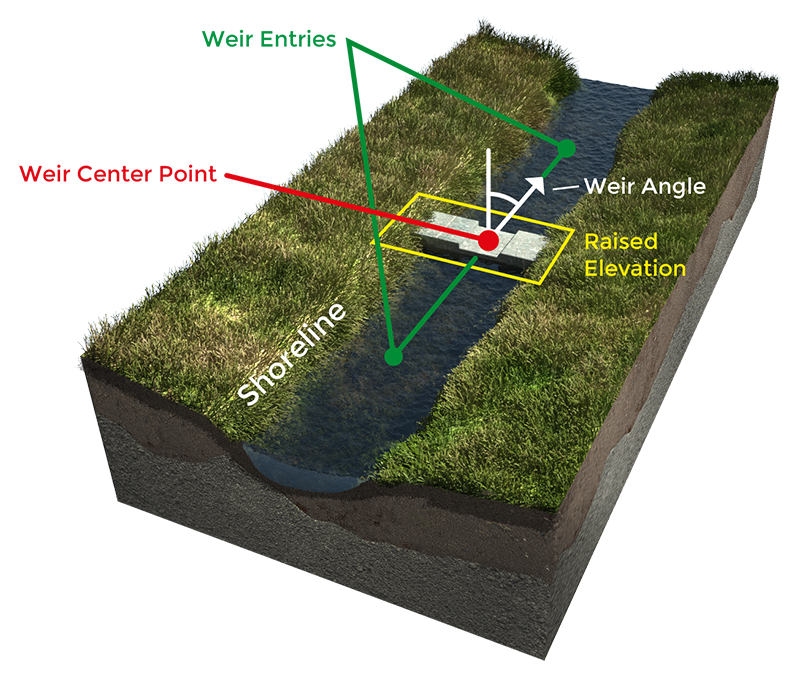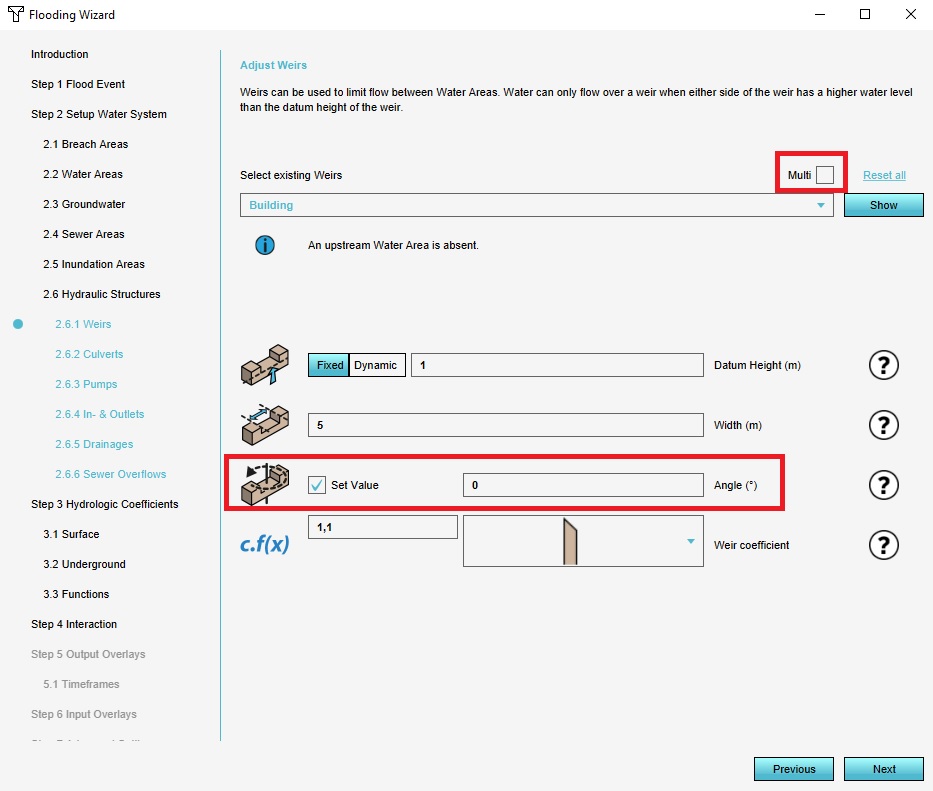Weir angle (Water Overlay): Difference between revisions
Jump to navigation
Jump to search
No edit summary |
No edit summary |
||
| Line 10: | Line 10: | ||
}}</onlyinclude>}} | }}</onlyinclude>}} | ||
The weir angle is used to convert a weir loaded in as point-based data to a line which is used in the simulation to define from where to where the water should flow across the weir. | The weir angle is used to convert a weir loaded in as point-based data to a line which is used in the simulation to define from where to where the water should flow across the weir. | ||
In the Water Wizard a weir angle is automatically generated. There are currently 4 options on how this is (automatically) generated: | |||
# The weir is located on the edge of 2 water level areas. The weir is then automatically installed correctly and no message is displayed. A note about this option is necessary: The weirs are automatically well oriented, but the waterways are not blocked, which means that water can flow past the weirs. That is why we recommend using a dataset in which the attribute is already present, because then the block is in effect. | |||
# The weir is located in exactly 1 level area. Then the warning appears that the weir has no angle, with the offer to fix it. | |||
# The weir is located in exactly 0 level areas. Then a comment is displayed abou the absence of a water level area. | |||
# The weir angle attribute is added to a data set upfront and this data set is imported in the project. No angle needs to be generated automatically. | |||
{{article end | {{article end | ||
| Line 16: | Line 21: | ||
* The width of the generated dam is equal to the weir's [[Weir width (Water Overlay)|WEIR_WIDTH]], multiplied by the [[Weir dam multiplier (Water Overlay)|WEIR_DAM_MULTIPLIER]] of the [[Water Overlay]]. | * The width of the generated dam is equal to the weir's [[Weir width (Water Overlay)|WEIR_WIDTH]], multiplied by the [[Weir dam multiplier (Water Overlay)|WEIR_DAM_MULTIPLIER]] of the [[Water Overlay]]. | ||
* If a weir angle is available for a weir which is already line-shaped, the weir is first interpreted as a point, and then the direction and elevation are adjusted accordingly. The centre of the weir's polygon is used. | * If a weir angle is available for a weir which is already line-shaped, the weir is first interpreted as a point, and then the direction and elevation are adjusted accordingly. The centre of the weir's polygon is used. | ||
* If no angle is available as an attribute, the angle weir angles are automatically oriented based on the water level areas | * If no angle is available as an attribute, the angle weir angles are automatically oriented based on the water level areas. | ||
. | . | ||
|seealso= | |seealso= | ||
Revision as of 09:35, 28 July 2021
| Icon | Key | Unit | Range | Description | Default value |
|---|---|---|---|---|---|
| |
WEIR_ANGLE | geo angle (0-360°) | The top down orientation angle of the weir. | 0 |
The weir angle is used to convert a weir loaded in as point-based data to a line which is used in the simulation to define from where to where the water should flow across the weir. In the Water Wizard a weir angle is automatically generated. There are currently 4 options on how this is (automatically) generated:
- The weir is located on the edge of 2 water level areas. The weir is then automatically installed correctly and no message is displayed. A note about this option is necessary: The weirs are automatically well oriented, but the waterways are not blocked, which means that water can flow past the weirs. That is why we recommend using a dataset in which the attribute is already present, because then the block is in effect.
- The weir is located in exactly 1 level area. Then the warning appears that the weir has no angle, with the offer to fix it.
- The weir is located in exactly 0 level areas. Then a comment is displayed abou the absence of a water level area.
- The weir angle attribute is added to a data set upfront and this data set is imported in the project. No angle needs to be generated automatically.
Notes
- The width of the generated dam is equal to the weir's WEIR_WIDTH, multiplied by the WEIR_DAM_MULTIPLIER of the Water Overlay.
- If a weir angle is available for a weir which is already line-shaped, the weir is first interpreted as a point, and then the direction and elevation are adjusted accordingly. The centre of the weir's polygon is used.
- If no angle is available as an attribute, the angle weir angles are automatically oriented based on the water level areas.
.






